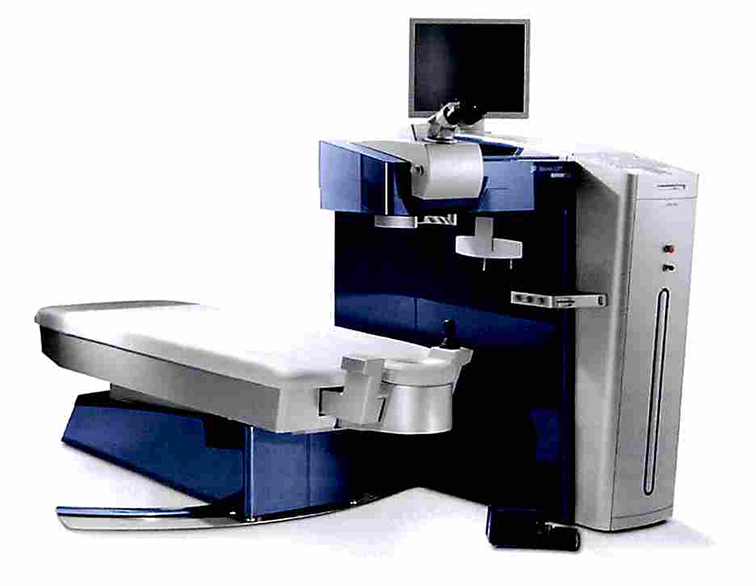FDA Approved Outcomes
More than 28 million LASIK procedures have been performed worldwide since 1989.
Click here to view the Wavelight LASIK Patient Information Booklet (Opens .pdf in a new window)
Important Safety Information about the WaveLight® Excimer Laser Systems

This information pertains to all WaveLight® Excimer Laser Systems, including the WaveLight® ALLEGRETTO WAVE®, the ALLEGRETTO WAVE® Eye-Q, and the WaveLight® EX500.
Caution: Federal (U.S.) law restricts the WaveLight® Excimer Laser Systems to sale by or on the order of a physician. Only practitioners who are experienced in the medical management and surgical treatment of the cornea, who have been trained in laser refractive surgery (including laser calibration and operation) should use a WaveLight® Excimer Laser System.
Indications: FDA has approved the WaveLight® Excimer Laser for use in laser-assisted in situ keratomileuses (LASIK) treatments for:
- the reduction or elimination of myopia of up to – 12.0 DS and up to 6.0 D of astigmatism at the spectacle plane;
- the reduction or elimination of hyperopia up to + 6.0 DS with and without astigmatic refractive errors up to 5.0 D at the spectacle plane, with a maximum manifest refraction spherical equivalent of + 6.0 D;
- the reduction or elimination of naturally occurring mixed astigmatism of up to 6.0 D at the spectacle plane; and
- the wavefront-guided reduction or elimination of myopia of up to -7.0 DS and up to 3.0 D of astigmatism at the spectacle plane.
The WaveLight® Excimer Laser Systems are only indicated for use in patients who are 18 years of age or older (21 years of age or older for mixed astigmatism) with documentation of a stable manifest refraction defined as ≤ 0.50 D of preoperative spherical equivalent shift over one year prior to surgery, exclusive of changes due to unmasking latent hyperopia.
Contraindications: The WaveLight® Excimer Laser Systems are contraindicated for use with patients who:
- are pregnant or nursing;
- have a diagnosed collagen vascular, autoimmune or immunodeficiency disease;
- have been diagnosed keratoconus or if there are any clinical pictures suggestive of keratoconus; or
- are taking isotretinoin (Accutane) and/or amiodarone hydrochloride (Cordarone).
Warnings: The WaveLight® Excimer Laser Systems are not recommended for use with patients who have:
- systemic diseases likely to affect wound healing, such as connective tissue disease, insulin-dependent diabetes, severe atopic disease or an immunocompromised status;
- history of Herpes simplex or Herpes zoster keratitis;
- a severely dry eye that is unresponsive to treatment;
- severe allergies; or
- an unreliable preoperative wavefront examination that precludes wavefront-guided treatment.
The wavefront-guided LASIK procedure requires accurate and reliable data from the wavefront examination. Every step of every wavefront measurement that may be used as the basis for a wavefront-guided LASIK procedure must be validated by the user. Inaccurate or unreliable data from the wavefront examination will lead to an inaccurate treatment.
Precautions: The safety and effectiveness of the WaveLight® Excimer Laser Systems have not been established for patients with:
- progressive myopia, hyperopia, astigmatism and/or mixed astigmatism, ocular disease, previous corneal or intraocular surgery, or trauma in the ablation zone;
- corneal abnormalities including, but not limited to, scars, irregular astigmatism, and corneal warpage;
- residual corneal thickness after ablation of fewer than 250 microns due to the increased risk for corneal ectasia;
- pupil size below 7.0 mm after mydriatics where applied for wavefront-guided ablation planning;
- history of glaucoma or ocular hypertension of > 23 mmHg;
- taking the medication sumatriptan succinate (Imitrex*);
- corneal, lens and/or vitreous opacities including, but not limited to cataract;
- iris problems including, but not limited to, coloboma and previous iris surgery compromising proper eye tracking; or
- taking medications likely to affect wound healing including (but not limited to) antimetabolites.
In addition, the safety and effectiveness of the WaveLight® Excimer Laser Systems have not been established for:
- treatments with an optical zone < 6.0 mm or > 6.5 mm in diameter, or an ablation zone > 9.0 mm in diameter; or
- wavefront-guided treatment targets different from emmetropia (plano) in which the wavefront calculated defocus (spherical term) has been adjusted;
In the WaveLight® Excimer Laser System clinical studies, there were few subjects with cylinder amounts > 4 D and ≤ 6 D. Not all complications, adverse events, and levels of effectiveness may have been determined for this population.
Pupil sizes should be evaluated under mesopic illumination conditions. Effects of treatment on vision under poor illumination cannot be predicted prior to surgery.
Adverse Events and Complications
Myopia: In the myopia clinical study, 0.2% (2/876) of the eyes had a lost, misplaced, or misaligned flap reported at the 1-month examination.
The following complications were reported 6 months after LASIK: 0.9% (7/818) had ghosting or double images in the operative eye; 0.1% (1/818) of the eyes had a corneal epithelial defect.
Hyperopia: In the hyperopia clinical study, 0.4% (1/276) of the eyes had a retinal detachment or retinal vascular accident reported at the 3-month examination.
The following complications were reported 6 months after LASIK: 0.8% (2/262) of the eyes had a corneal epithelial defect and 0.8% (2/262) had any epithelium in the interface.
Mixed Astigmatism: In the mixed astigmatism clinical study, two adverse events were reported. The first event involved a patient who postoperatively was subject to blunt trauma to the treatment eye 6 days after surgery. The patient was found to have an intact globe with no rupture, inflammation or any dislodgement of the flap. UCVA was decreased due to this event. The second event involved the treatment of an incorrect axis of astigmatism. The axis was treated at 60 degrees instead of 160 degrees.
The following complications were reported 6 months after LASIK: 1.8% (2/111) of the eyes had ghosting or double images in the operative eye.
Wavefront-Guided Myopia: No adverse events occurred during the postoperative period of the wavefront-guided LASIK procedures. In the Control Cohort (traditional LASIK treatment) one subject undergoing traditional LASIK had the axis of astigmatism programmed as 115 degrees instead of the actual 155-degree axis. This led to a cylinder in the left eye.
The following complications were reported 6 months after wavefront-guided LASIK in the Study Cohort: 1.2% (2/166) of the eyes had a corneal epithelial defect; 1.2% (2/166) had foreign body sensation, and 0.6% (1/166) had pain. No complications were reported in the Control Cohort.
Clinical Data
Myopia: The myopia clinical study included 901 eyes treated, of which 813 of 866 eligible eyes were followed for 12 months. Accountability at 3 months was 93.8%, at 6 months was 91.9%, and at 12 months was 93.9%. Of the 782 eyes eligible for the uncorrected visual acuity (UCVA) analysis of effectiveness at the 6-month stability time point, 98.3%were corrected to 20/40 or better, and 87.7% were corrected to 20/20 or better. Subjects who responded to a patient satisfaction questionnaire before and after LASIK reported the following visual symptoms at a “moderate” or “severe” level at least 1% higher at 3 months post-treatment than at baseline: visual fluctuations (28.6% vs. 12.8% at baseline).
Long term risks of LASIK for myopia with and without astigmatism have not been studied beyond 12 months.
Hyperopia: The hyperopia clinical study included 290 eyes treated,of which 100 of 290 eligible eyes were followed for 12 months. Accountability at 3 months was 95.2%, at 6 months was 93.9%, and at 12 months was 69.9%. Of the 212 eyes eligible for the UCVA analysis of effectiveness at the 6-month stability time point, 95.3% were corrected to 20/40 or better, and 69.4% were corrected to 20/20 or better. Subjects who responded to a patient satisfaction questionnaire before and after LASIK reported the following visual symptoms as “much worse” at 6 months post-treatment: halos (6.4%); visual fluctuations (6.1%); light sensitivity (4.9%); night driving glare (4.2%); and glare from bright lights (3.0%). Long term risks of LASIK for hyperopia with and without astigmatism have not been studied beyond 12 months.
Mixed Astigmatism: The mixed astigmatism clinical study included 162 eyes treated, of which 111 were eligible to be followed for 6 months. Accountability at 1 month was 99.4%, at 3 months was 96.0%, and at 6 months was 100.0%. Of the 142 eyes eligible for the UCVA analysis of effectiveness at the 6-month stability time point, 97.3% achieved acuity of 20/40 or better, and 69.4% achieved acuity of 20/20 or better. Subjects who responded to a patient satisfaction questionnaire before and after LASIK reported the following visual symptoms at a “moderate” or “severe” level at least 1% higher at 3 months post-treatment than at baseline: sensitivity to light (52.9% vs. 43.3% at baseline); visual fluctuations (43.0% vs. 32.1% at baseline); and halos (42.3% vs. 37.0% at baseline). Long term risks of LASIK for mixed astigmatism have not been studied beyond 6 months.
Wavefront-Guided Myopia: The wavefront-guided myopia clinical study included 374 eyes treated; 188 with wavefront-guided LASIK (Study Cohort) and 186 with Wavefront Optimized® LASIK (Control Cohort). 166 of the Study Cohort and 166 of the Control Cohort were eligible to be followed at 6 months. In the Study Cohort, accountability at 1 month was 96.8%, at 3 months was 96.8%, and at 6 months was 93.3%. In the Control Cohort, accountability at 1 month was 94.6%, at 3 months was 94.6%, and at 6 months was 92.2%.
Of the 166 eyes in the Study Cohort that were eligible for the UCVA analysis of effectiveness at the 6-month stability time point, 99.4% were corrected to 20/40 or better, and 93.4% were corrected to 20/20 or better. Of the 166 eyes in the Control Cohort eligible for the UCVA analysis of effectiveness at the 6-month stability time point, 99.4% were corrected to 20/40 or better, and 92.8% were corrected to 20/20.
In the Study Cohort, subjects who responded to a patient satisfaction questionnaire before and after LASIK reported the following visual symptoms at a “moderate” or “severe” level at least 1% higher at 3 months post-treatment than at baseline: light sensitivity (47.8% vs. 37.2% at baseline) and visual fluctuations (20.0% vs. 13.8% at baseline). In the Control Cohort, the following visual symptoms were reported at a “moderate” or “severe” level at least 1% higher at 3 months post-treatment than at baseline: halos (45.4% vs. 36.6% at baseline) and visual fluctuations (21.9% vs. 18.3% at baseline). Long term risks of wavefront-guided LASIK for myopia with and without astigmatism have not been studied beyond 6 months.
Information for Patients: Prior to undergoing LASIK surgery with a WaveLight® Excimer Laser System, prospective patients must receive a copy of the relevant Patient Information Booklet, and must be informed of the alternatives for correcting their vision, including (but not limited to) eyeglasses, contact lenses, photorefractive keratectomy, and other refractive surgeries.
Attention: Please refer to a current WaveLight® Excimer Laser System Procedure Manual for a complete listing of the indications, complications, warnings, precautions, and side effects.
Important Safety Information about the WaveLight® FS200 Laser System
Caution: Federal (USA) law restricts this device to sale by, or on the order of, a physician.
Indications: The WaveLight® FS200 Laser System is indicated for use in the creation of a corneal flap in patients undergoing LASIK surgery or other surgery or treatment requiring initial lamellar resection of the cornea; in patients undergoing surgery or other treatment requiring initial lamellar resection of the cornea to create tunnels for placement of corneal ring segments; in the creation of a lamellar cut/resection of the cornea for lamellar keratoplasty; and in the creation of a penetrating cut/incision for penetrating keratoplasty and for corneal harvesting.
The WaveLight® FS200 delivery system is used in conjunction with a sterile disposable Patient Interface, consisting of pre-sterilized suction ring assemblies and pre-sterilized applanation cones, intended for single use.
The WaveLight® FS200 Laser System should only be operated by, or under the direct supervision of, a trained physician with certification in laser safety and in the use of the WaveLight® FS200 Laser.
Contraindications: LASIK treatments are contraindicated in: Pregnant or nursing women; patients with a diagnosed collagen vascular, autoimmune or immunodeficiency disease; and patients who are taking one or both of the following medications: isotretinoin (Accutane), amiodarone hydrochloride (Cordarone).
Flap Contraindications: Lamellar resection for the creation of a corneal flap using the WaveLight® FS200 laser is
contraindicated if any of the following conditions exist. Potential contraindications are not limited to those included in this list: corneal edema; corneal lesions; hypotony; glaucoma; existing corneal implant; and keratoconus.
Keratoplasty Contraindications: Penetrating cut/incision (for penetrating keratoplasty) is contraindicated in: any corneal opacity adequately dense to obscure visualization of the iris; descemetocoete with impending corneal rupture; previous corneal incisions that might provide a potential space into which the gas produced by the procedure can escape; and corneal thickness requirements that are beyond the range of the System.
Other Considerations: The following conditions should also be considered: severe corneal thinning; subjects with pre-existing glaucoma; a history of steroid-responsive rise in intraocular pressure; preoperative intraocular pressure greater than 21 mmHg in the operative eye; subjects with more than 1000 μm corneal thickness at the 9 mm peripheral zone; active intraocular inflammation; and active ocular infection.
Warnings: Any treatment with the WaveLight® FS200 is not recommended in patients who have: systemic diseases likely to affect wound healing, such as connective tissue disease, insulin-dependent diabetes, severe atopic disease or an immunocompromised status; a history of Herpes simplex or Herpes zoster keratitis; significant dry eye that is unresponsive to treatment; severe allergies; and a history of glaucoma or ocular hypertension.
Complications: Possible complications which may result from flap cutting include (potential complications are not limited to those included in this list): corneal edema; corneal pain; epithelial ingrowth; epithelial infection; flap de-centration; incomplete flap creation; flap tearing or incomplete lift-off; free cap; photophobia; corneal inflammation, such as diffuse lamellar keratitis (DLK), corneal infiltrates and iritis; thin or thick flaps; flap striae; and corneal ectasia (secondary keratoconus).
Adverse Events:
Transient Light Sensitivity Syndrome (TLSS): Transient Light Sensitivity Syndrome is characterized by symptoms of mild to severe light sensitivity which manifests between two and six weeks postoperatively. Patients experience no decrease in uncorrected or best spectacle-corrected visual acuity. The incidence of this sensitivity was observed in approximately 1% of patients who undergo flap creation with a femtosecond laser.* Patients respond to the use of hourly topical steroids such as prednisolone acetate, and most report improvement within one week of treatment.
Peripheral Light Spectrum (PLS): Peripheral Light Spectrum is a temporary phenomenon whereby patients report the perception of a spoke-like spectrum of light in the periphery of their vision. PLS has no clinical examination findings and no effect on visual acuity; however, the potential diffractive effects may be bothersome to some patients. Reported in only a small amount of cases, the onset of symptoms occurs during the immediate postoperative period, and typically resolves within three months but may be slightly persistent in rare cases. The visual impact of PLS is clinically inconsequential for the vast majority of patients.
Attention: Please refer to a current WaveLight® FS200 Laser System Procedure Manual for a complete listing of the indications, complications, warnings, precautions, and side effects.
*Trademarks are the property of their respective owners.


